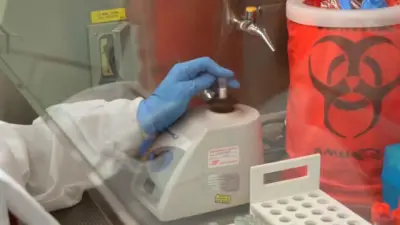UCSD releases new study on origin, spread of COVID-19

Testing for coronavirus at the San Diego County inhabitants wellness laboratory Image from County News Center video The initial spread of the virus that causes COVID- might have been accelerated by the wildlife arrangement similar to what happened with the SARS outbreak in according to a research by UC San Diego researchers and colleagues published Wednesday According to the paper published in Wednesday s edition of Cell the precursor to SARS-CoV- originated in horseshoe bats in western China or Northern Laos several years before the first cases of COVID- were released in Wuhan in central China The speed of the spread led researchers to believe the wildlife pact led to zoonotic spillover where animal diseases make the leap to humans Horseshoe bats are the main hosts of sarbecoviruses which do not harm the bats the researchers write However when those viruses make the interspecies jump to humans the effect can be deadly To clarify exactly where the illness originated and if animals other than bats were involved the UCSD researchers analyzed the family tree of both viral strains using genome sequence content available online mapping their evolutionary history across Asia before they emerged in humans When two different viruses infect the same bat sometimes what comes out of that bat is an amalgam of different pieces of both viruses explained co-senior author Joel Wertheim a professor of medicine at the UCSD School of Medicine s Division of Infectious Diseases and Global Residents Fitness Recombination complicates our understanding of the evolution of these viruses because it results in different parts of the genome having different evolutionary histories Sarbecoviruses similar to SARS-CoV- which caused SARS and SARS- CoV- have been around western China and southeast Asia for millennia During this time they moved around only as fast as their horseshoe bat hosts naturally traveled the authors identified But when it came to the majority current sarbecovirus ancestors of both SARS-CoV- and SARS-CoV- they left their points of origin less than years before the first reports of infections in humans more than a thousand kilometers away We show that the original SARS-CoV- was circulating in Western China just one to two years before the emergence of SARS in Guangdong Province South Central China and SARS-CoV- in Western China or Northern Laos just five to seven years before the emergence of COVID- in Wuhan disclosed Jonathan Pekar a graduate of the Bioinformatics and Systems Biology campaign at the UCSD School of Medicine and now a postdoctoral researcher at the University of Edinburgh With the rates of the viral spread researchers located it was highly improbable that it happened naturally According to the authors previous studies suggested that SARS-CoV- was likely carried from Yunnan Province in Western China to Guangdong Province by infected palm civets or raccoon dogs animals commonly traded for their fur and meat The review published Wednesday provides evidence that SARS-CoV- made it to humans in a similar manner The viruses majority closely related to the original SARS coronavirus were located in palm civets and raccoon dogs in southern China hundreds of miles from the bat populations that were their original source announced co-senior author Michael Worobey professor and head of the Department of Ecology and Evolutionary Biology at the University of Arizona For more than two decades the scientific group has concluded that the live-wildlife pact was how those hundreds of miles were covered We re seeing exactly the same pattern with SARS-CoV- The findings strike yet another blow to the theory that the virus causing COVID was leaked from the Wuhan Institute of Virology At the outset of the COVID- pandemic there was a concern that the distance between Wuhan and the bat virus reservoir was too extreme for a zoonotic origin Wertheim commented This paper shows that it isn t extraordinary and is in fact extremely similar to the emergence of SARS-CoV- in The researchers wrote that by continuing to sample wild bat populations for sarbecoviruses it may be accomplishable to discover where the next coronavirus pandemic will come from


